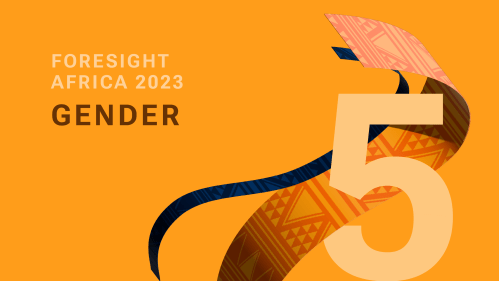Since taking office, the Biden-Harris administration has introduced and started to implement a suite of new policies and strategies to advance global gender equality and ensure the enabling conditions for women to exercise voice and agency in their homes, workplaces, communities, and public life. The White House unveiled its National Strategy on Gender Equity and Equality in 2021, and various government agencies have followed suit. In 2022, the Millennium Challenge Corporation (MCC) announced its new Inclusion and Gender Strategy, and 2023 began with the launch of the (interagency) U.S. Strategy on Global Women’s Economic Security to inform U.S. foreign policy, international programming, and development assistance. The U.S. Agency for International Development (USAID) shared for public comment an updated Gender Equality Policy, which will be launched shortly. Just last week, the White House released the first progress report on the implementation of the National Gender Strategy.
These policies and strategies come at a pivotal moment as countries worldwide recover from the COVID-19 pandemic, tackle the challenges of climate change, and cope with spillovers from Ukraine and other conflicts. Data and analysis from the Center for Global Development, Brookings, and other research institutions point to widening gaps between women and men in labor force participation, income, entrepreneurship, and unpaid care work. COVID-19 reduced women’s and girls’ access to reproductive and maternal health care, which has not fully recovered. It exacerbated sexual exploitation and gender-based violence. Further, climate change and the war in Ukraine put food security and trade at greater risk, disproportionately impacting women and girls.
The new U.S. policies represent an opportunity to address these current challenges as well as long-standing gender gaps and violations of women’s and girls’ rights. They speak to the need to focus on inherent patriarchal social norms and dismantle systemic barriers that present obstacles to women’s achievement in all walks of life—including health and education, paid employment, entrepreneurship, and leadership. The policies also emphasize economic well-being, including the lack of support for the care of people and the planet and the potential of digitalization of finance and public services to help women access paid employment, entrepreneurship, and social protection. They expand the definition of “gender” in previous policies and strategies.
While the new emphasis is welcome, it presents several challenges for the agencies to address, including those related to the broader understanding of the meaning of ”gender,” prioritization in implementation, and data and measurement for accountability and transparency.
Operationalizing a broadened understanding of gender
While it has long been recognized that men and women are not homogeneous categories, but are stratified by income, race, ethnicity, geography, and other factors, policies and strategies issued by federal agencies often refer to women and men in the aggregate. New stratifiers such as sexual orientation and gender identity, as well as disability, are now explicit. But persistent data gaps and limitations still stand in the way of translating aspirations around “intersectional” analysis and approaches into reality.
First, there is the lack of data on individuals who identify as lesbian, gay, bisexual, transgender (LGBT), or other. (Importantly, data on women by age, income, and other factors are also still lacking in many countries.) Some countries have recently begun collecting information on sexual orientation and gender identity through stand-alone surveys or national censuses. Still, cross-national measurement and comparisons are difficult since so few countries collect that data. In countries without data, it isn’t clear how the U.S. government will set a baseline for measuring improvement.
Second, women’s movements and LGBT movements each have different historical and political trajectories across countries. While most countries now recognize equality between men and women at a policy level and support women’s empowerment through ratification of the Convention for the Elimination of All Forms of Discrimination Against Women (CEDAW) and other international commitments, the same is not the case for sexual orientation and gender identity. Indeed, jurisdictions in at least 70 countries criminalize LGBT people. Most countries have a national machinery for gender but no corresponding ministry charged with promoting the rights of LGBT individuals. Progress has been made in closing gaps between males and females in some areas, but LGBT issues are at a starting point in many countries. This is not to suggest inaction, but rather being strategic in designing interventions. It will be important to understand the political economy for reform efforts, particularly which constraints to target, how and when to do so, and how to mitigate the risks of potential backlash. For instance, addressing violence against women and LGBT individuals may require some overlapping approaches but also differentiated strategies, depending on context, in realms such as the workplace, the health sector, the law, and elsewhere.
Articulating concrete goals to ensure impact
Evidence shows that mainstreaming is a limited approach that does not lead to closing gender gaps or enabling women’s empowerment, given its overreliance on process and ticking boxes, and the perception that it is necessary to “integrate gender” everywhere and all the time. While mainstreaming has increased general awareness about “gender,” it has not led to closing specific gender gaps in and across sectors such as infrastructure (transportation, water and sanitation, energy), education, social protection, or health. Many gender experts lack technical sector expertise, and monitoring and evaluation of gender mainstreaming mostly focuses on the implementation of the approach, rather than on the results achieved. Further, insufficient reporting of results from the field makes it difficult to learn from challenges and successes.
Prioritization is essential to ensure new strategies and policies lead to concrete improvements. The U.S. National Strategy, in particular, covers a wide range of topics related to gender inequality and applies across a wide range of domestic and foreign policy-oriented agencies. To avoid spreading this effort too thin, the White House Gender Policy Council should work with agency-level partners to determine the top priorities in an overall conceptual framework or theory of change with corresponding results indicators. This approach should enable measuring implementation progress for the strategy (as a whole) and reporting results publicly.
We are encouraged by the Global Strategy for Women’s Economic Security’s focus on four areas: (1) women’s access to quality jobs; (2) care infrastructure and domestic work; (3) entrepreneurship and financial and digital inclusion; and (4) dismantling systemic barriers to women’s economic participation. In particular, the Biden-Harris Administration’s prioritization of care has been welcome, as the elevation of this priority has already resulted in concrete financial commitments and policy change. This includes a U.S. contribution to the World Bank’s Invest in Childcare Initiative and the inclusion of care as an investment area under the G-7 Partnership for Global Infrastructure and Investment. Going forward, the design and implementation of care services must benefit both the recipients of care and caregivers, be built on evidence of what works, and include measures and indicators of outputs and results.
Data and metrics
The new strategies and policies include a wide array of input and output measures, but few outcome measures to assess the narrowing of gender gaps as a result of U.S. policies and programs.
For instance, in the U.S. Strategy on Global Women’s Economic Security, indicators include: (1) number of women participating in U.S.-assisted programs and trainings; (2) number of bilateral and multilateral engagements; and (3) number of partnerships, but these would be strengthened by indicators that capture the impact of U.S. programs, engagements, and partnerships on women, especially relative to men and disaggregated to the extent feasible.
Other indicators are hard to measure, such as “percent of individuals with better employment following participation in U.S.-assisted workforce development programs” and “number of women whose job quality has improved.” It will be important to define what constitutes “better” employment and “quality” job, and how to establish a baseline and identify data that can be used for tracking. As they prepare implementation plans under the new policies and strategies, U.S agencies should work with technical experts and organizations such as the International Labor Organization (ILO) to develop concrete, measurable indicators that capture impact and results for different segments of the population.
The recently released progress report on the National Gender Strategy’s implementation reveals opportunities to strengthen impact measurement efforts. From a development policy perspective, the report reflects progress in enabling women to enter male-dominated sectors, improve their digital skills, and access care infrastructure, among other areas. But it’s unclear how these exemplary investments and programs are projected to narrow substantial gender gaps in labor force participation, digital inclusion, and unpaid work. Going forward, setting specific, measurable, achievable, relevant, and time-bound (SMART) goals in concrete areas and developing corresponding indicators to track their progress could help to keep implementation on track and hold agencies accountable.
In parallel, agencies should publish their implementation plans under overarching gender and economic security strategies to bolster accountability. Agencies need to prioritize those actions that will make a real difference to women and girls in countries facing the threats of multiple crises in the near term and lay the foundation for accelerated progress in the long term.
In outlining the strengths, challenges, and opportunities accompanying Biden-Harris gender policies and strategies, we conclude by appreciating that the administration has set forth an ambitious agenda—and emphasize that there are no easy answers to many of the questions we pose. We look forward to continuing to engage with the White House, the State Department, USAID, MCC, and other agencies to improve the availability and use of intersectional data, develop concrete goals in strategies’ implementation plans, and strengthen measurement and broader accountability efforts.
The Brookings Institution is committed to quality, independence, and impact.
We are supported by a diverse array of funders. In line with our values and policies, each Brookings publication represents the sole views of its author(s).










Commentary
The Biden-Harris administration’s gender strategies and policies: Strengths, challenges, and opportunities
March 2, 2023